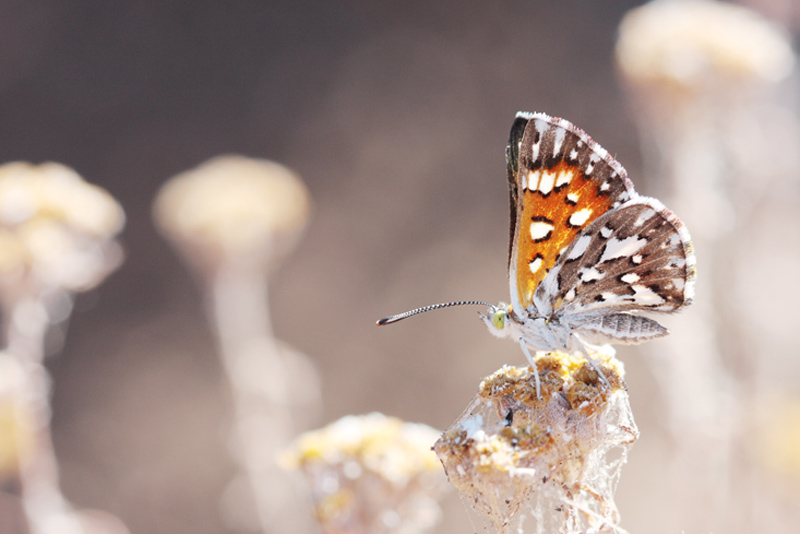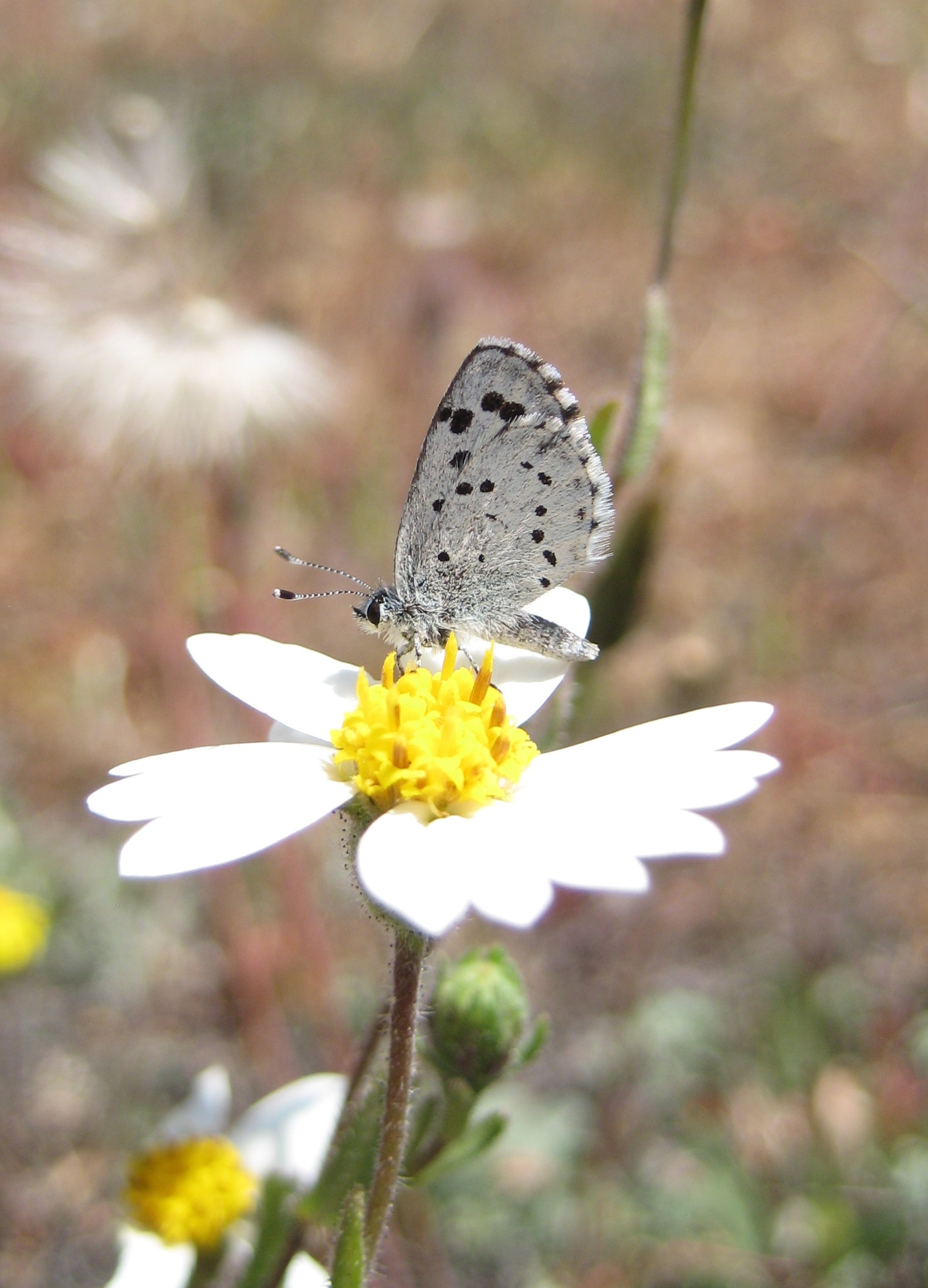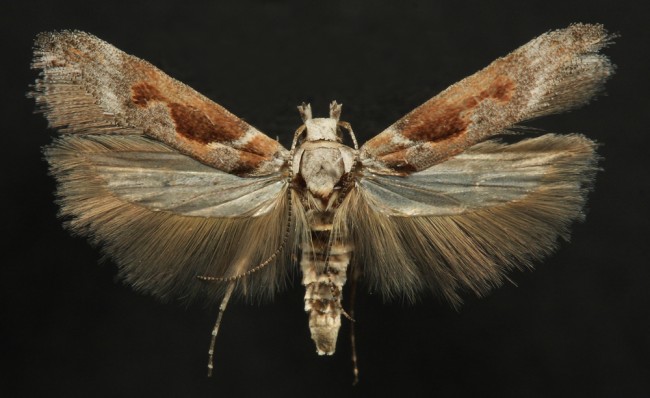Af Chris Grinter, on February 24th, 2010

Know this butterfly? It’s OK, no one really does. It is in the genus Apodemia (Riodinidae), but the taxonomy of this group is a disaster… and don’t even get me started on the subspecies. This specimen was photographed in September, meaning it is most likely to be Apodemia mormo (mormo) based on flight time. En. mormo is a fall flyer and En. virgulti is a spring flyer. While some forms seem distinctive, there is massive morphological overlap and they are usually identical and sympatric – actually down to living on the same plants. But according to lab experiments it is impossible to get the pupae to break diapause so they remain reproductively isolated. So are they different? While molecular work is being conducted the verdict is out, but it does seem like these two species may be retained in the end. Og selvfølgelig, each mountain range has it’s own subspecies. Who knows, I sure don’t. I’m glad I don’t work on butterflies.
Species concepts are a fuzzy line and it’s never clear exactly where to make the cut. When asked what a species is most people default to the Mayr concept of Biological Species (BSC), where reproductive isolation = new. This is all well and good but we have to keep in mind that this is not the ONLY species concept. Der er snesevis, and not one is perfect. Groups like Grammia (Ugler: Arctiinae) exhibit high levels of hybridization, which does not adhere well to the BSC. I like to apply as many criteria as possible to delimit a species and it seems like the line is all too commonly thin within insects. I like to see a distinguishing morphological trait, if not in wing color or pattern, at the least in the genitalia or antennae. This is not always the case however and you have to look at the biology and/or DNA. I have looked at two insects that are for all intents and purposes identical. But the biology is radically different and a large % difference (løbet 8% – ja, arbitrary) in their DNA makes it unquestionable that they are separate.
And if species weren’t contentious enough subspecies stir the pot even more. I’m skeptical about the entire concept, but there are cases in which it seems plausible and necessary. A subspecies is a more formal definition of a geographical “form” and usually exhibits a blend zone into another subspecies. For instance if you look at the 27 different populations of Plebejus icarioides there are large differences between northern and southern populations, but very subtile difference along the gradient. It is that persistent gradient that creates one dynamic species instead of 27 separate species – at least according to current research. Moths have been lucky and have thus far avoided the plague of over-subspeciation, butterflies not so much. There may even be instances where greedy collectors have named new subspecies of Parnassius for profit (new rare butterfly subspecies sell for big bucks).
The truth is that species concepts are artificial, poorly understood and dynamic at best; at worst it approaches a soft science with no real possibility of proof. Yet species are real and theories will continue to adapt while we sit here and scratch our heads.
Af Chris Grinter, den 23. februar, 2010 

En af fordelene ved at være en entomolog er at rejse og indsamle. Jeg lagde et par tusinde miles på bilen hver sommer, og det er to af de bedste steder i Arizona at indsamle. Det øverste billede er fra Baboquivari -bjergene (Baboquivari Peak i midten), Brown Canyon Research Station. Det nederste billede er af Pena Blanca Canyon, en berømt indsamling hotspot. Denne kløft er bare 5 miles fra Mexico og har et par sikkerhedsproblemer på grund af vores nuværende immigrationspolitik. En morgen, mens du sorterer møl fra de foregående nætter fangst, en kollega og jeg havde en gruppe på groft 30 illegale går lige igennem vores lejr. De var godt klædte og rene på, vinkede, og må lige være blevet afleveret ved hegnet. Heldigvis er størstedelen af de illegale hårdtarbejdende og ærlige mennesker, der forsøger at tjene et bedre liv. Det er coyoter og smuglere, der er skræmmende – Jeg har hørt historier om mexicansk politi, der eskorterer narkotika -campingvogne til USA med tungt artilleri. Og bare sidste år blev en grænsepatruljeagent stukket ihjel af en prærieulv i denne nærhed.
Heldigvis, en flok mærkelige fyre, der står omkring mærkelige lys om natten, giver os en bred køje.
(Er disse billeder små nok til hurtigt at indlæse?)
Af Chris Grinter, den 23. februar, 2010 På trods af at jeg er ret uinteresseret i sommerfugle, de er smukke at se på. Her er en rigtig god video af en fyr, jeg kender nede i det sydlige CA. Hans time-lapse-videoer af lepidoptera-livscyklusser er ret imponerende, og især denne er smuk. Hvis du skærer til ca 3:00 i, you will see dozens of Great Purple Hairstreaks (Atlides halesus) emerging from their chrysalises, the colors are stunning. This butterfly is native to the SW and Mexico, and I have to admit I love finding it in the field.
[youtube = http://www.youtube.com/watch?v=KyWJlpIchkE]
Af Chris Grinter, den 23. februar, 2010 The brief comment about Linus Pauling and Vitamin C below made me remember this video first posted a while ago by Pharyngula. This is Kary Mullis, the inventor of PCR, and a Nobel Prize winner. His invention basically made DNA analysis possible. But like Pauling, he is also completely and totally nuts. If you have the time to listen to him ramble, give it a shot. Men kort sagt, he discusses astrology, denies global warming and how AIDS is not caused by HIV. I wonder what the stats are for genius scientists that slide off their rocker?
[Vimeo 9167379]
Af Chris Grinter, på februar 22, 2010 
Dette er et gammelt billede af mig, så det er ikke perfekt. Hvis du kan fortælle mig denne sommerfugl til arter, får du en high-five. Hvis du kender underarten, Jeg sender dig en ny pakke med #3 stifter i rustfrit stål! Kun antydning: Det er fra det vestlige USA.
Af Chris Grinter, på februar 22, 2010 I dag fandt jeg dette artikel i NY Times sundhed – udråber fordelene ved akupunktur anvendes til depression lindring hos gravide kvinder. Jeg har et par problemer med journalisten, Shirley S. Wang, undlade at forblive skeptisk i hendes stykke. Men det kommer ikke som nogen overraskelse, så jeg gider ikke at påpege åbenlyse fejl i medierne.
Jeg vil påpege fejlene i undersøgelsen. Vedlagt den oprindelige fulde tekst, her. Så efter at have læst dette papir jeg er kommet til et par konklusioner.
1) Meget lille stikprøve af 150 patienter, kun 141 behandlet.
2) Undersøgelsen er blindet KUN for depression scoring, ikke administration af akupunktur. Faktisk, deres frigivelse stater "Deltagerne i en af disse to grupper vil modtage akupunktur, der fokuserer på depression symptomer og den anden behandling vil ikke." Giver mening, at få en nål stukket i din hud er let at lægge mærke til. Så, disse “randomiseret og blindet” deltagerne vidste, hvad der kommer og antages, at ethvert stikke skulle hjælpe deres depression. Endvidere, dette (meget bedre) undersøgelse har vist, at simuleret akupunktur med tandstikkere virker lige det samme. Omhyggelig, dette er overbevisende beviser mod gyldigheden af akupunktur – ikke evidens for nytten af stimuleret “trykpunkter”. Det er en placebo-effekt.
3) Undersøgelse forudsætter gyldigheden af “depression specifik” og “ikke-specifik” akupunktur. Betydning én metode til bens stikning måde helbreder depression over en anden. Hvad er dette baseret på? Åh vent, de siger præcis den udtømmende videnskabelige beviser lige her: “mønstre af disharmoni i henhold til principperne for traditionel kinesisk medicin”. Jeg er ked af det, venligst, give mig moderne medicin i løbet af 2,000 årige mytiske overbevisninger. Hvordan var den gennemsnitlige livskvalitet og forventede levealder for en gammel kineser? Pretty damn forfærdelige, og jeg er sikker på den gennemsnitlige levealder ikke overstige 35 år.
4) Baseres depressionsscore på én administration af DSM-IV Hamilton Rating Scale. Ikke bliver en psykiater, jeg kan ikke tale til effekten af disse tests. Men, Jeg vil gå ud på en lem og antager, at der bør etableres en stærkere baseline for depression før sammenligne resultater. Testen kan være nøjagtig, men hvorfor ikke administrere det mere end én gang for at reducere støj.
5) Udvælgelse af massage som en anden kontrol. Det er en dårlig forsøg på symbolsk skepsis, de selv angive ret off the bat “Massage blev udtænkt som en kontrol behandling, fordi, selv om det forbedrer humør umiddelbart efter en session, der ikke er tilstrækkelig dokumentation til støtte for dens effektivitet som en behandling for depression.” Når jeg designer en undersøgelse, jeg kan lide at se på alle kendte faktorer, som jeg tror vil modbevise min hypotese. Vælge noget, som du allerede tror vil kun mislykkes, viser deres hånd grov partiskhed.
6) Manglende kontrol for socioøkonomiske faktorer. 67% af deltagerne var hvide, hvoraf størstedelen var veluddannede. De har endda gå så langt som til at anføre i diskussionen “Derfor, resultater måske ikke generalisere til bestemte minoritetsgrupper, der blev underrepræsenteret i vores prøve”. Er det bare mig, eller er denne erklæring negere hele deres forskning? De er frit indrømme, at akupunktur ikke kan arbejde så godt i andre minoritetsgrupper. Hvorfor kunne det være? Den eneste logiske og videnskabelige svar er, at en placebo-effekt adskiller tværs socioøkonomiske grænser. Hvis, efter alle, akupunktur var en legitim medicinsk videnskab, der ville være en ubetydelig forskel set på tværs af fysiologisk identiske organismer.
Denne undersøgelse er forfærdeligt dårligt videnskab. Disse forskere er begyndt med den forudsætning, at akupunktur virker, og søge efter data til støtte for deres påstande. Dette er præcis modsatte af, hvordan man fører virkelige videnskab. Og, vores sundhed reporter på NY Times gjorde ikke engang bat et øje. Fail for dig fru. Wang, og undlader at NY Times.
Af Chris Grinter, on February 21st, 2010 I love Ming Tsai and his cooking empire as much as the next 3-am TV viewer. Faktisk, his recipes are fantastic and you should make them yourself. But I have noticed an odd tendency for him to say (paraphrased) “you should always use organic, it’s much better for you”. This leaves me a bit puzzled. What exactly does he mean? Ming is well-educated and this is not anything he should be solely responsible for, but he echoes an all too common misconception that organic is actually better. By better I am interpreting this as healthier, which seems to be a logical gap to bridge. Så, let’s look at the data.
A recent and comprehensive review published in the American Journal of Clinical Nutrition has largely convinced me of what I was always skeptical of; that organic foods can not actually be healthier for you. In their breakdown they cited 55 studies and came to the conclusion that “there is no evidence of a difference in nutrient quality between organically and conventionally produced foodstuffs”.
So what is the harm? My problem with all of this is that it is based on the naturalistic fallacy, that “natural” eller “organic” somehow means that the product is safer or healthier. How many times do you see the term “natural” in the store and never give it second thought? If natural things really were safer then traditional Ayurvedic medicines would not be horribly toxic. Afterall, arsenic, lead and mercury are NATURAL – but they are also some of the most toxic compounds known to man. In the end it is 100% marketing.
Taken from another angle Ming Tsai may not be all that incorrect afterall. I do not have all the data in front of me regarding pesticide contamination of foodstuffs, but it is logical to assume the less contaminated the better. Obviously pesticides can be a bad thing, there are mountains of literature to support the damage they can cause. But the jury seems out on exactly how bad, hvis overhovedet, these minute residues on our foods are. Conventionally grown foods have regulated levels of residues, but even organics are not free of pesticide contamination. So I look at it differently. Our environment benefits from having safer food. Less chemicals are dumped into our waterways, farmers have to battle less with incredibly powerful toxins, og blinky the fish fights to see another day. We should all strive to live sustainably and organic farming does provide us with an edge.
So once again, what is the harm? People who buy organic quite possibly do so based on genuine environmental stewardship. I would also argue that a very high percentage of these people also believe these foods are healthier (anyone have survey data to support this claim?). So in this instance the result is a net positive. Men, being right for the wrong reasons should never be acceptable. This strikes at the peak of a larger problem that is driven by marketing and zero science. Case in point – Vitamin C as a cold remedy. A study in PLOS medicine has shown there is no indication for efficacy of VitC against the common cold. Gå figur, a once believed to be true staple has begun to be picked apart by science and data. Let’s be careful on what bandwagon we jump and why.
Af Chris Grinter, on February 21st, 2010 [youtube = http://www.youtube.com/watch?v=zSgiXGELjbc]
I really enjoy this autotuned Sagan, makes me with I was this eloquent. Watch more videos here at the Symphony of Science.
Af Chris Grinter, on February 21st, 2010  Så, how do I begin a new blog? Tough question, but perhaps this is a good time to show off a fun new species. This moth was collected last year outside of Santa Barbara, Californien. The massive wingspan, at 15mm, makes it pretty large for a Gelechiid moth. The genus, Gnorimoschema (pronounced nor-a-mosh-ma), seems to be far more species rich than is currently known, so this creature comes as no surprise. It also gives me a chance to brag about the benefits of studying such a wonderfully diverse group of animals. If you happen to be lucky enough to be a friend of mine you’ll probably get your own species at some point. Så, how do I begin a new blog? Tough question, but perhaps this is a good time to show off a fun new species. This moth was collected last year outside of Santa Barbara, Californien. The massive wingspan, at 15mm, makes it pretty large for a Gelechiid moth. The genus, Gnorimoschema (pronounced nor-a-mosh-ma), seems to be far more species rich than is currently known, so this creature comes as no surprise. It also gives me a chance to brag about the benefits of studying such a wonderfully diverse group of animals. If you happen to be lucky enough to be a friend of mine you’ll probably get your own species at some point.
På den anden side, this also highlights the problem – knowing almost nothing about the most diverse group of animals on our planet. What happens when a new crop is being eaten by a tiny, nondescript, møl? Call one of the dozen people in the world who might be able to help you. Maybe they know what it is, but likely nothing is known about its biology. This is what happened in South Dakota recently when biofuel crops were being eaten by a moth last seen in 1910. What a perfect reason for more funding! More likely than not my new moth above will never explode into a pest. But having basic knowledge of the species that share this earth with us is a step in the right direction.
|
Skepsis
|





